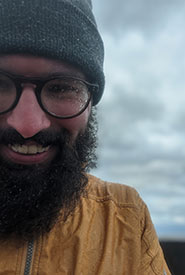The big picture
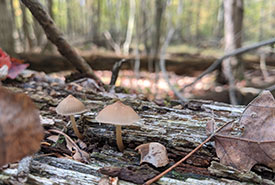
A fallen tree can be home to mushrooms (Photo by NCC)
I have learned so much more about natural ecosystems during my recent participation in the Canadian Conservation Corps (CCC) program. Natural ecosystems are created by an intricate relationship between the land, the plants, the animals and all the living beings in a particular setting. They have been developing and ever changing for decades, centuries, millennia…. Those ecosystems have been shaped by everything that surrounds them: land topography, bodies of water, vegetation, animals and their migratory patterns, wildfires, droughts and floods. Some cycles are easy for us to see, like the geese migration during spring and autumn. Since we are absorbed in our daily routines and sometimes forget to look outside, we often miss the small details or the long cycles.
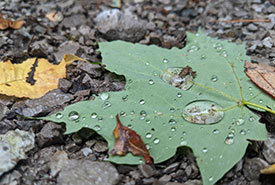
Maple leaf, a source of wonder (Photo by NCC)
As humans, we have shaped the land we live on for millennia. If we want to give the land a chance to go back its prime, before we, humans, impacted it carelessly, we need to give it the help it deserves and time. A lot of time. We can notice shorter cycles from season to season or from year to year. However, some cycles necessary for a viable ecosystem often take more patience. These cycles can take years, decades or centuries to happen. Think about the centennial floods that we all know too well but usually forget. I know it might be hard to think about something we might not even experience in our lifetime, but acknowledging it is the first step.
Conservation is hard work and needs a lot of time and effort to see it through. I have come to understand that even small actions can have wonderful impacts over time. The first year of rebuilding the natural ecosystem of a field might look like unkept long grasses and unwanted weeds. Only after a few years, a wider diversity of native species, such as grasses, wildflowers and shrubs, can be seen. Once these plants are back on the landscape, insects, small mammals and reptiles will come back to their natural environment. In time, some predators will also come back to keep a balance within the re-emerging ecosystem. Trees may start to grow on the edges of the prairie from seeds dropped by mature trees or carried by birds and small animals.
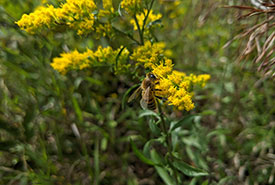
Goldenrods provide food for bees (Photo by NCC)
The solid oak rising high above the ground will be a refuge for birds. The oak that fell a long time ago will be a refuge for insects and mammals. Every flower will be a feast for bees, just like spiders and flies will be a feast for the wasps’ offspring. Acorns might grow into trees, but often, they will feed the squirrels and chipmunks. The tree canopy will block some sunlight for plants that are more sensitive, giving them both the perfect opportunity to thrive.
As part of my program with the CCC, I did an internship with the Nature Conservancy of Canada (NCC). My main tasks were to remove invasive species on properties we were restoring. I have learned that not everything is always as it seems. Non-native plants were brought by humans, intentionally or not, from different ecosystems and can have a pretty negative impact on ours. Some of my work with NCC was removing invasive phragmites, as it can take over ponds, leaving no space for other native plants to grow and for birds to land on the water. Another task was to remove Asian bittersweet, which is a type of vine that creeps onto trees and covers their whole foliage, overwhelming them and, over time, breaking down those trees under their now unbearable weight. This is where we can make a positive impact while the ecosystem is getting back on its feet. Small efforts add up to big outcomes.
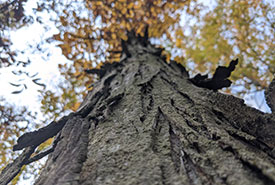
Shagbark hickory can provide habitat for bats (Photo by NCC)
Conservation can look messy and hard to get your head around, but everything is always worth its while in the long run. Nature has no agenda but its own terms, no deadline but infinite time and no judgement but open arms. We need to make amends for all the poor decisions humans have taken in the past. This is our home, and the only one we have. Nature is full of different ecosystems and if we want to preserve it, we need to see the big picture, put in efforts and give it time.

